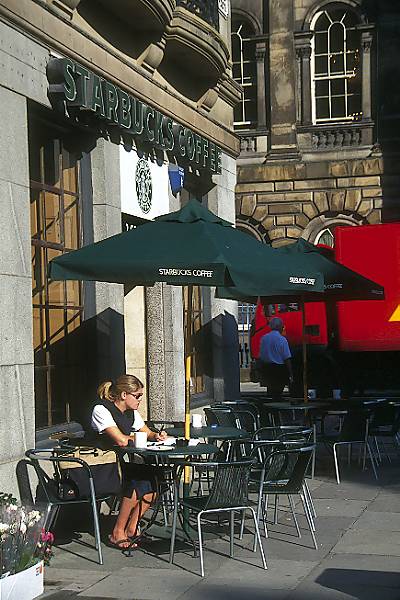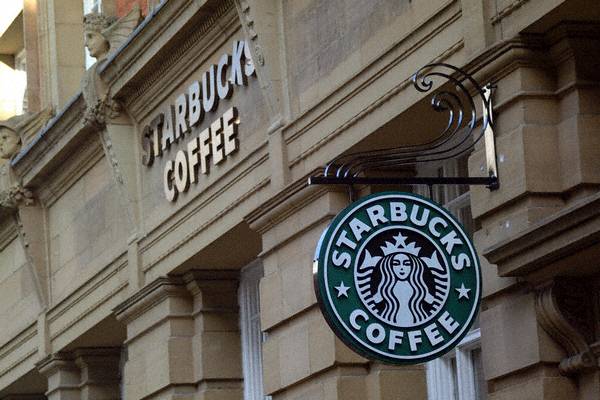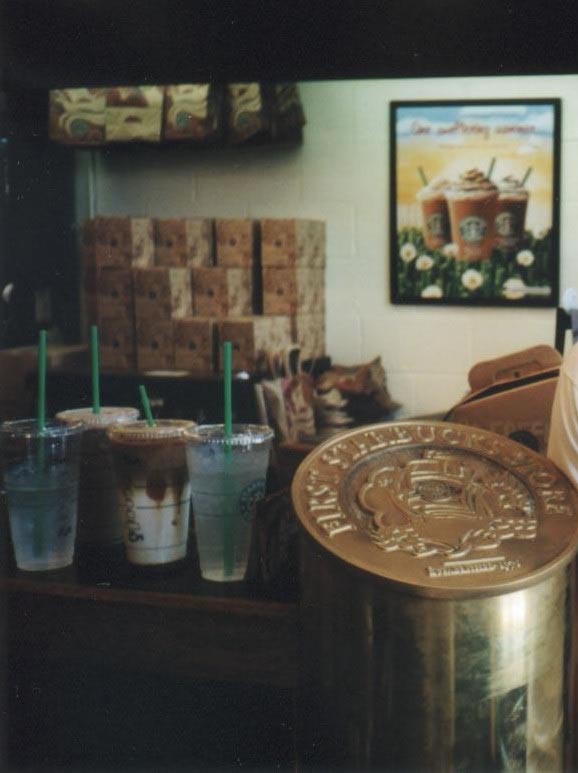
Starbucks,
Liverpool

Starbucks, York

Inside Starbucks, Seattle

Synthesis
A
comprehensive understanding of Starbucks as a themed space requires
insight into both the cultural and political economy perspectives of
urban theory. Both perspectives contribute to Starbucks’ success
as a profitable themed space capitalizing on cutting edge trends of
urbanization.
To compete in today’s hyper-consumer economy it is no longer enough
to simply have a legitimate business. Today’s economy is one that
demands product differentiation and design. In order to succeed, a business
must offer that extra pizzazz to make it stand out as the place consumers
want to go. The perfect combination of wide variety and the comfort
of familiarity set in an appealing atmosphere contributes to Starbucks'
extra pizzazz, in effect, giving it that edge and making it the most
successful coffee shop in the world.
Starbucks offers something that no other coffeehouse offers at the same caliber. The fact is, that walking into a Starbucks and ordering is hassle free in comparison to entering the unknown ‘mom-and-pop’ coffee shop. All Starbucks menus are practically identical. One could more than likely know exactly what they want to order before even entering the store. However, at a small local shop, the consumer may face obstacles such as a foreign menu, a hidden bathroom, hand-me-down couches (God forbid), or possibly a poorly brewed beverage. Starbucks promises comfortable familiarity at every location. The Starbucks experience is consistent and inviting, evoking an instant tradition in all receptive customers.
Yet,
in spite of all the comfortable familiarity, the Starbucks experience
remains varied. The Starbucks menu offers a wide selection of tasty
treats and other products, ranging from an enormous selection of coffees
and teas to pastries, mugs, CDs and seasonal gifts, just to name a few.
Starbucks has something for everyone and more than enough selection
to keep the customers coming back time and time again, be it for their
usual coffee fix or for something new and exciting they have yet to
try.
All this, comfortable familiarity and endless selection, comes in quite
the Starbucks package. Starbucks everywhere maintain relatively the
same leisure atmosphere (after all it is a themed space). The characteristic
Starbucks ambiance is created by carefully choosing mood music, a varied
assortment of Jazz, easy listening, and cultural selections, comfy,
but attractive, couches and chairs, and always big open windows set
in aesthetically pleasing architecture with carefully planned color
scheming. Place this package in almost any upper middle class neighborhood
and there you have Starbucks. The Starbucks environment practically
fits an equation. However, as calculated as this equation may be, not
everyone appreciates the final product.
The themed space of Starbucks is actually a hotly contested contemporary issue. Though in combination, the political economy and cultural perspectives seem to take into account all relevant key issues, it seems that the Starbucks corporation refuses to recognize the detrimental aspects of its expansion. Starbucks engenders social conflicts in the neighborhoods it occupies. When Starbucks moves into an area, it not only forces the local ‘mom-and-pop’ coffee shops to go out of business, but it also indirectly spurs a widespread displacement of the original inhabitants of the given area; When Starbucks moves in, rents generally go up. Furthermore, those inhabitants who can afford newly inflated rent often feel alienated from their own neighborhoods due to the aforementioned dislocation of the local, familiar shops they knew and loved. Starbucks’ very presence in a place can drastically alter the dynamic of that place, and, as illustrated, that change does not please everyone.